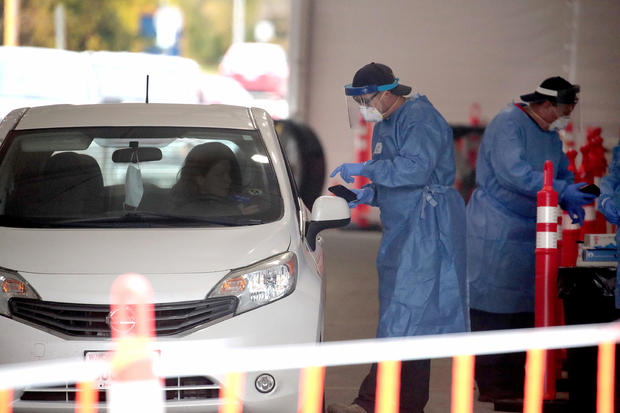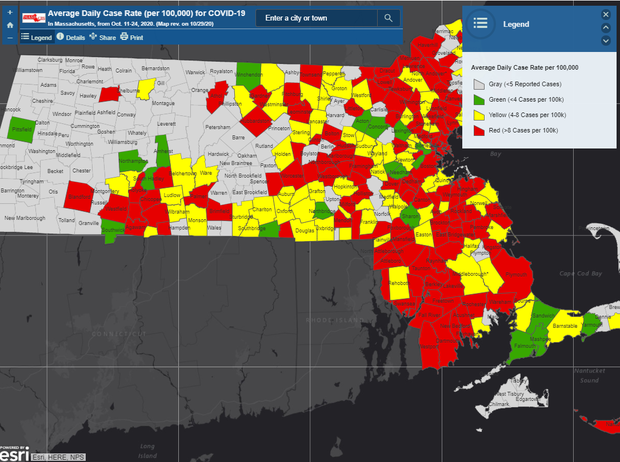U.S. reports record number of new COVID-19 cases
get the free appThe United States reported 88,521 new COVID-19 cases on Thursday – more cases than have ever been reported before in a single day during the pandemic. The country is now approaching 9 million confirmed cases, and more than 228,000 people have died due to the virus.
Test positive rates have been climbing across 45 states, according to the COVID Tracking Project. Over a dozen states have test positive rates of 10% or more, indicating widespread virus transmission.
Boosted restrictions to help stem the spread have rolled out in some parts of the U.S., while Europe is seeing new lockdowns. People streamed out of Paris on Thursday before France locked down. Next week, a new lockdown will come into effect in Germany.
Contributing: The Associated Press
Georgia's governor and first lady are quarantining
Georgia Governor Brian Kemp's press secretary said in a tweet Friday that the governor and first lady Marty Kemp are quarantining after recent exposure to someone who tested positive for COVID-19.
Kemp and the first lady have taken a COVID-19 test, Cody Hall tweeted.
Shortly after the announcement, congressman Drew Ferguson tweeted that he tested positive for COVID-19 after feeling ill Thursday night. Ferguson said he will be self-quarantining and working from home.
Virus antibody drug paused for safety issue
A study testing an experimental antibody drug for the coronavirus has been paused to investigate a possible safety issue.
Regeneron Pharmaceuticals said Friday that independent monitors had recommended placing on hold enrollment of the most severely ill patients -- those who need intense oxygen treatment or breathing machines -- because of a potential safety problem and unfavorable balance of risks and benefits.
The study can continue to test the two-antibody drug combo in hospitalized patients who need little or no extra oxygen. Other studies in mild or moderately ill people also are continuing.
Earlier this month, a study testing a similar drug from Eli Lilly in hospitalized patients was paused and later stopped because the drug didn't seem to help. Experts say previous testing suggests these antibody drugs may help most when given early in infection.
North Dakota surpasses 500 COVID-19 deaths as cases rise
North Dakota's death toll from COVID-19 surpassed 500 on Friday, and on the day health officials reported new daily highs for hospitalizations and new infections from the virus.
The North Dakota Department of Health reported 13 new deaths, bringing the statewide death toll from the virus to 512. Data shows 241 of the deaths occurred in October.
Health officials also reported seven hospitalizations in the last day due to the coronavirus, increasing the total number of patients in medical facilities to a record 191. There were 216 available inpatient beds plus 20 intensive care unit beds in North Dakota, according to state data.
There were new 1,357 infections from the virus on Friday, an increase of 135 from the previous record set Thursday.
Health officials reported a daily positivity rate of 12.1%.
The COVID Tracking Project reported that North Dakota has had 5,510 new cases per 100,000 people over the past two weeks, which leads the nation. The rolling average number of daily new cases has increased by more than 42% in the last two weeks, according to Johns Hopkins University researchers.
EU: WHO should have more power to investigate outbreaks
European countries are calling for the World Health Organization to be given greater powers to independently investigate outbreaks and compel countries to provide more data, after the pandemic highlighted the agency's numerous shortcomings.
WHO currently has no powers to independently investigate epidemics and must instead rely on countries to approve its list of proposed experts for any visit and is largely subject to an agenda set by the countries.
After a meeting between European Union ministers to discuss how the U.N. health agency should be strengthened, German health minister Jens Spahn said Friday the WHO should receive more political support and financial backing for its international efforts to manage acute health crises.
"The WHO can't be on its own and carry the weight of this pandemic alone," he said at a press briefing.
Stella Kyriakides, the EU Health Commissioner, noted that EU institutions provided $100 million to WHO last year.
The agency was repeatedly criticized by President Trump for "colluding" with China to cover up the initial extent of the pandemic. Mr. Trump later withdrew U.S. funding for WHO – the U.S. was the agency's single-biggest donor – and later pulled the U.S. out of the organization altogether.
In a draft document provided by the German Health Ministry and the European Commission Friday, EU member states said the extraordinary demands of COVID-19 "outweigh the current WHO capacities and its ability to support member states."
The countries underlined their support for the WHO, but suggested several proposals to revamp the agency.
Doctor says deaths not as high as in spring, but warns anyone can die from virus
A doctor said Friday the death rate due to COVID-19 isn't as high as the level witnessed earlier this year when the region was hit hard by the virus. But he warned that anyone can die from the virus.
"We are not seeing the kind of mortality or deaths that we saw back in the early spring," said Dr. Bob Lahita, a professor of medicine at New York Medical College and the chairman of Medicine at St. Joseph's Healthcare System.
"The reason could be that people who are vulnerable or advanced age and have comorbidities are wearing masks and social distancing," he said.
"But we are seeing an uptick in this area of New York and New Jersey, an uptick of cases that come into the emergency room," he said.
He said when you get infected "you do not know whether you're going to be one of the people who dies. And that is ageless."
"There's no age range that I can say, well, if you're 40 you're not gonna die. You can be 20 years of age and die from this virus," he said. "We simply don't know what pre-existing factors are other than we know that comorbidities and advanced age are major factors. But anyone can get this infection and die."
He said the fact that virus case numbers are going up "means people aren't mitigating. They're not wearing masks, they're not social distancing."
How Americans felt about masks during the 1918 flu pandemic
As Election Day nears, the role of masks during the coronavirus pandemic has become highly politicized; while health experts have emphasized how masks can reduce spread, mask rules across the country have varied and so has the response from Americans.
More than a century ago, during the 1918 flu pandemic, there were some similar feelings about masks.
As Americans were celebrating victory in World War I in the fall of 1918, the masks on returning troops showed that the U.S. was losing another war against the so-called Spanish Flu.
Masks were controversial back then "for many of the same reasons they are today," said Nancy Tomes, a history professor at the State University of New York at Stony Brook.
The pandemic in 1918 got "really, really bad," she told "CBS This Morning" co-host Anthony Mason. "We refer to it as the Big One among historians of medicine."
About 675,000 Americans would die, nearly a third of them in a single month. The Red Cross spread the slogan "wear a mask, save your life," and nurses began to make them for the public.
Donald Trump Jr. says COVID deaths have dropped to "almost nothing"
Donald Trump Jr. claimed that COVID-19 deaths have dropped to "almost nothing" Thursday, a day that saw a record-breaking number of new cases in which almost 1,000 Americans died of the virus.
In an interview with Fox News anchor Laura Ingraham, President Trump's son said that data from the Centers for Disease Control and Prevention (CDC) showed a declining death rate.
"I went through the CDC data, because I kept hearing about new infections, but I was like, 'Why aren't they talking about this?'" Trump Jr. said. "Oh, because the number is almost nothing. Because we've gotten control of this thing, we understand how it works. They have the therapeutics to be able to deal with this."
Trump Jr. also pointed to a post on his Instagram account that he claimed gave a more accurate picture of deaths in the U.S. "If you look at my Instagram account, it's gone to almost nothing," Trump Jr. said.
Over 228,000 Americans have died from COVID-19 and nearly 9 million have contracted the virus. There were nearly 89,000 new cases in the U.S. on Thursday, breaking the single-day record for new cases, and nearly 1,000 deaths, according to Johns Hopkins University.
Trump Jr.'s words echo those of his father, who has also downplayed the severity of the pandemic.
With Minnesota breaking COVID records, are hospitals ready?
Health leaders warn that Minnesota is nearing the "explosive growth" in COVID-19 cases seen in neighboring states. Minnesota set a new daily record Thursday of 2,872 cases, and Department of Health Commissioner Jan Malcolm expects that record to soon be broken.
More people are in Minnesota hospitals with COVID right now than at any other point during the pandemic, CBS Minnesota reports.
"[The phrase] 'Flatten the curve' has to come back," said Helen Strike, the president of both Regina Hospital and River Falls Hospital in the Allina Health system.
Dr. Haylee Veazey, who works in emergency and primary care for Hennepin Healthcare, says the numbers are scary. Malcolm called them alarming. Veazey says more sick patients are coming into the hospital now than earlier this year. Malcolm says the surge isn't from one or two big events, but from thousands of smaller, individual decisions.
The good news is hospitals are better equipped now for COVID patients than when this all started. Treatments have also improved, and Strike says hospital stays can be shorter. She added that we all have the power to fight the pandemic through our behavior.
"It's really the time that we refocus on wearing our masks, watching our distance and washing our hands," Veazey said. "Those things really do work. We've seen it work in other populations and our own population."
Strike says COVID patients released from the hospital aren't necessarily out of the woods. Many still need specialty care and some will have long-term health impacts.
121 communities in Mass. considered high risk for infections
More than a third of Massachusetts, a total of 121 communities, are now considered high risk for coronavirus infections. Six of those communities have been impacted by a cluster at a long-term care facility, college or prison, CBS Boston reports.
The state released an updated color-coded map and data on Thursday based on average positive test rates.
NYC hospitals prepare for virus resurgence
New York City hospitals and nursing homes are bracing for a potential resurgence of COVID patients, drawing on lessons learned in the spring when the outbreak brought the city to its knees.
The new playbook derives from the apocalyptic days of March and April, when testing and resources were scarce, emergency rooms overflowed, and funeral homes stacked corpses in refrigerated trailers. Those insights make it far less likely that the city's hospitals would collapse under another COVID-19 wave, health care leaders say.
Even without a vaccine, doctors are touting increasingly effective coronavirus treatments, three-month supplies of personal protective equipment and contingency staffing plans.
Similar preparations are underway at New York's hard hit nursing homes, which accounted for a staggering percentage of the state's coronavirus deaths.
"We didn't even have testing in February when there was so much transmission," Dr. Mitchell Katz, head of the city's public hospital system, said in an interview. "I can't see how we'd ever have the same situation that we had in March and April, but we are preparing for that possibility anyway."
Not only has critical care improved, Katz said, but patients also are generally "not getting as intense as an exposure as they once did because of the wearing of masks." New cases also are afflicting younger people, who are less likely than older patients to need hospitalization.
Traffic hits record levels around Paris before lockdown
Traffic hit record levels around Paris before a new lockdown in France went into effect at midnight, BBC News reports.
People are being ordered to mostly stay at home, and many left Paris for the countryside for more space, the BBC reported, citing French media. Many motorists also were leaving to celebrate this weekend's All Saints' Day holiday.
French President Emmanuel Macron said authorities would be "tolerant" about families returning from the holidays on Monday, but that inter-regional travel is otherwise strictly prohibited.
The four-week lockdown that went into force at midnight requires residents to stay home except for one hour of daily exercise or to attend medical appointments or to shop for essentials. President Emmanuel Macron said the country risked being "overwhelmed by a second wave that no doubt will be harder than the first."
Daily Covid-19 deaths in France are at the highest level since April, and on Thursday, authorities reported 47,637 new cases and 250 new deaths.
-CBS/AP
Lockdown considered as Belgian virus cases rise
Belgian coronavirus cases continued their record rise on Friday before the government met to consider even tougher restrictions on movements that would amount to a quasi-lockdown. After surpassing the spring record on Thursday, the number of patients in Belgian hospitals broke the 6,000-mark and stood at 6,187, a rise of 263 in a day.
"Unfortunately, we cannot yet see the long-expected turnaround in figures," said virologist Steven Van Gucht.
After measures were beefed up earlier in the week, the government was to meet again later Friday to consider further restrictions. Non-essential shops are expected to face temporary closure.
Patients in intensive care units reached 1,057 from 993 the day earlier, and virologists have warned that unless tougher measures have a quick impact the saturation point of 2,000 patients will be reached on Nov. 6. Hospital authorities are demanding tougher action since they say the health system is at the point of collapse.
Along with the Czech Republic, Belgium is one of the top two nations in Europe where the virus is hitting hardest at the moment.
The number of positive cases per 100,000 over the past 14 days stood at 1,609, which is bound to keep Belgium in the European top two going into the weekend. Van Gucht said that the true total is higher because testing has been reduced for specific categories of people.
Germany reports new daily record of 18,681 cases
Germany's disease control agency reported Friday that the country saw another new daily record number of confirmed cases, with 18,681. The new cases take the country's total in the pandemic to almost half a million.
Meanwhile, German authorities have added almost all Austria and Italy to the list of high-risk areas for COVID-19. Travelers returning to Germany from countries or regions on the list, which is updated weekly, have to go into 14-day quarantine and take a test for the coronavirus.
Those with negative test results can end their quarantines.
Critics have pointed out that the threshold of 50 new cases per 100,000 inhabitants per week, which is the main criteria for determining which countries appear on the list, has now been passed in much of Germany itself.


